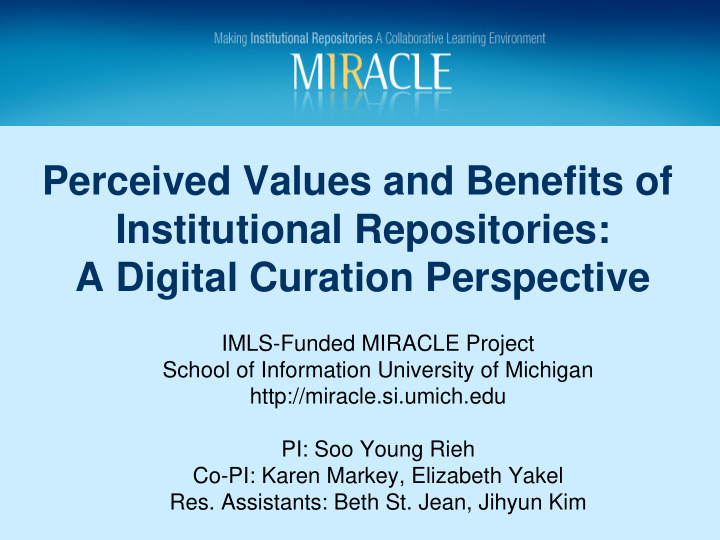



Perceived Values and Benefits of Institutional Repositories: A Digital Curation Perspective IMLS-Funded MIRACLE Project School of Information University of Michigan http://miracle.si.umich.edu PI: Soo Young Rieh Co-PI: Karen Markey, Elizabeth Yakel Res. Assistants: Beth St. Jean, Jihyun Kim
MIRACLE Project Goal • Institutional Repositories – IRs are increasingly deployed in academic institutions to manage a variety of digital content including educational, research, and archival materials • Goal – To identify models and best practices in the administration, technical infrastructure, and access to repository collections
Major Project Activities • Completed Activities : – Nationwide Census of IRs – Telephone interviews with IR staff • Future Plans – Case studies of 5 IRs – Survey of IR users – Experimental study of IR searchers
Values and Benefits of IRs • IR values and benefits and digital curation – Spans the information life-cycle – Conceptualizing the benefits of IRs effects all other digital curation decisions – Identification of explicit benefits and values would assist IR administrators and staff in justifying the establishment of an IR
Research Questions • Do IR administrators and staff agree on a set of values and benefits of IRs? • To what extent do IR administrators and staff understand the role of digital curation in the process of IR establishment?
IR Values and Benefits from Census • National Census of IRs: Web-based Survey – 2,147 Email invitations to academic library directors or senior administrators – 446 responses (Response rate 20.8%) • Library directors (73.7%), library staff (10.2%), assistant-associate library directors (7.9%), archivists (2.3%), and chief information officers (CIOs) (2.0%).
Extent of IR Implementation Implementation (IMP): 48 Planning and Pilot Testing (PPT): 70 Planning Only (PO): 92 No Planning (NP): 236
Research Universities and IRs • 83 research universities responded: – 30 Implemented (36%) – 26 Planning and Pilot Testing (31%) – 14 Planning Only (16%) – 13 No Planning (15%) • 48 IMP institutions (CCHE classes) – 30 Research universities (63%) – 1 Doctoral university (2%) – 9 Master’s (19%) – 5 Baccalaureate (10%)
Top-ranked IR Benefits
Middle-ranked Benefits
Bottom-ranked benefits
Increasingly positive nature of respondents' ratings for IR benefits
Increases in Importance of Benefits for Institutions with Operational IRs • An increase in your library’s role as a viable partner in the research enterprise (48.7%) • Longtime preservation of your institution’s digital output (35.0 %) • An increase in the accessibility to knowledge assets such as numeric, video, audio, and multimedia datasets (35.0%) • Better service to contributors (34.2%) • Better services to your institution’s learning community (34.2%)
IR Values and Benefits from Phone Interviews • 176 Volunteers for phone interviews from the Census • A purposive sample of 36 participants – IR stage of development – Various positions: library staff (11), library directors (9), assistant-associate library directors (4), archivists or directors of archives (4), heads or directors in libraries (4), CIOs (3), associate dean for research (1) – Size and type of institution (small colleges to large research universities) – Geographically dispersed
Major Findings from Phone Interviews • Unique digital collection building – Faculty e-prints, student work, and archival primary source material • Centralizing access to digital collections – Making digital objects accessible any time anywhere • Use and sharing of IR materials – More usage, and increasingly importance of sharing resources • IRs as an intellectual preservation venue – Concerns and perceived risk in “making the promise that you’re going to keep it forever.”
Conclusion • IRs require a digital curation perspective • Management of digital assets – Digital collection building – Access to digital collection – Use of IR materials – Long-term preservation • IR policies and practices for digital curation vary depending on the size (Carnegie Classification) and IR development stage (NP, PO, PPT, and IMP)
Next Steps • Further analyses of phone interviews – General characteristics of IRs, content and content recruitment, policies and access, end users and use of IR, preservation, services, evaluation, financial issues, institutional commitment, intellectual property rights, IR system features, maintenance, and selection, metadata… • Case studies of five IRs • Survey of IR users • Experimental study of IR searchers
Stay Tuned on MIRALCE Project • Project Web site: http://miracle.si.umich.edu • Markey, K. Rieh, S. Y., St. Jean, B., Kim, J., & Yakel, E. (2007, February). Census of Institutional Repositories in the United States: MIRACLE Project Research Findings. Washington, D.C.: Council on Library and Information Resources. Available: http://www.clir.org/pubs/reports/pub140/pub140.pdf.
Recommend
More recommend